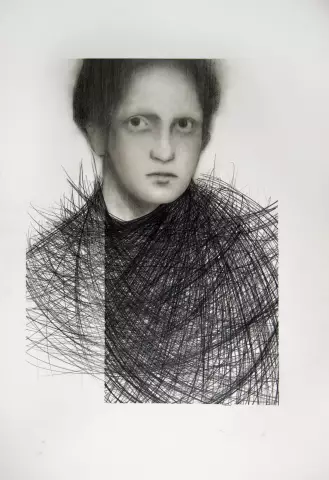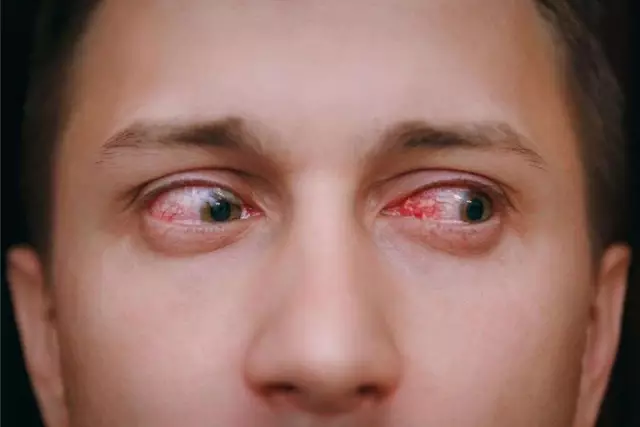- Author Rachel Wainwright [email protected].
- Public 2023-12-15 07:39.
- Last modified 2025-11-02 20:14.
Trachoma

An infectious disease of the conjunctiva of the eyes caused by microscopic intracellular parasites Chlamydia trachomatis is called trachoma. The causative agent is very variable, it exhibits properties inherent in both viruses and bacteria.
Not immediately after the discovery of chlamydia, the relationship between damage to the mucous membrane of the eyes and the presence of the parasite in the human body was clarified. But studies have shown that it is chlamydia that is the culprit for the development of trachoma, in which the mucous membranes and cornea are damaged. The disease leads to cicatricial changes not only in the conjunctiva, but also in the cartilage tissue, which in turn leads to complete blindness.
The source of infection is a sick person with an active form of the disease, but the greatest danger in terms of infection are patients with erased and atypical forms of trachoma, as well as carriers of the trachoma virus. The disease is transmitted by contact and household contact with objects contaminated with tears or discharge from the eyes.
Trachoma can develop regardless of age and gender, but most often the disease affects children and women. Currently, the disease is widespread in Africa and Southeast Asia, in other states it occurs in isolated cases.
Trachoma symptoms
From the moment of infection until the first signs of the disease appear, it takes from 7 to 16 days. But in most cases, trachoma is initially asymptomatic. The disease is detected during routine preventive examinations. Sometimes the following symptoms of trachoma are observed in patients: a feeling of sand in the eyes, a scanty discharge of a mucopurulent nature, a burning sensation, and increased eye fatigue. In the acute onset of trachoma, the symptoms are similar to acute conjunctivitis, in which there is swelling of the eyelids, hyperemia of the mucous membranes of the eyes, photophobia, and the amount of purulent discharge also increases.
With the introduction of the trachoma virus, the roughness of the mucous membrane of the eye first appears, then the cartilage thickens and specific ptosis develops. In a sick person, the eyelids are always parted, the face becomes sleepy.
One of the symptoms of trachoma is the formation of capsules around the follicles, inside which the pathogen remains. For many years, the trachoma virus may not be active, but under favorable circumstances, the integrity of the capsule is disrupted and a relapse of the disease occurs.
Stages of trachoma
In the classical form, trachoma proceeds as follows: first there is a suspicion of this disease, then pre-follicular trachoma develops, when hyperemia of the mucous membranes of the eye appears, but follicles have not yet formed, then four stages of trachoma itself follow.
Stage 1 - the conjunctiva is edematous and hyperemic, enlarged papillae and follicles are clearly visible on it.
Stage 2 - against the background of pronounced inflammation, the follicles merge, the disintegration of some of them becomes noticeable. Scar formation begins. At this stage of trachoma, the virus is the most active, the patient is contagious to others.
Stage 3 - the inflammation subsides, the number of follicles is less and less, the process of scarring begins to prevail. But often at this stage, an exacerbation of the disease occurs.
Stage 4 - the patient recovers. There are no signs of inflammation; numerous scars remain on the conjunctiva of the eyelids.
Complications of trachoma
Trachoma poses a danger not so much by the course of the disease as by the development of complications. Some of them are provoked by cicatricial changes, for example, fusion of the eyeball with the conjunctiva, volvulus of the eyelids, dry eye syndrome.
When a secondary infection of a viral or bacterial etiology is attached, inflammatory phenomena are observed in the lacrimal canals and the conjunctiva with the development of diseases such as dacryocystitis, dacryoadenitis, acute and chronic conjunctivitis.
But the most serious complication of trachoma is a corneal ulcer, which can be accompanied by perforation, an inflammatory process in the tissues of the eyeball and the iris.
As a rule, complications arise with improper treatment of trachoma, insufficient amount of drug therapy, or an incomplete course of taking drugs.
Trachoma treatment

A single case of the disease does not pose a particular danger to the organs of vision, therefore, the treatment of trachoma is usually local. One to two weeks after the start of treatment, if necessary, the follicles are opened under local anesthesia.
The patient is prescribed ointments and solutions, which include antibiotics (oletthrin, erythromycin, tetracycline), sulfonamides (etazole) or sodium sulfapyridazine. Medicines should be placed or dripped into the conjunctival sac, or dripped three to six times a day. A full course of trachoma treatment can last up to six months.
If the course of the disease is delayed or signs of a secondary infection appear, then in these cases antibiotics are prescribed in the form of injections and sulfonamides in tablet form. As an additional treatment for trachoma, vitamins, immunomodulators, antihistamines are used. In case of eyelid deformity and other complications of trachoma, surgical treatment.
Correct and timely treatment of trachoma allows avoiding the development of complications and subsequent repetitions of the disease. In general, the prognosis for trachoma is favorable.
YouTube video related to the article:
The information is generalized and provided for informational purposes only. At the first sign of illness, see your doctor. Self-medication is hazardous to health!






